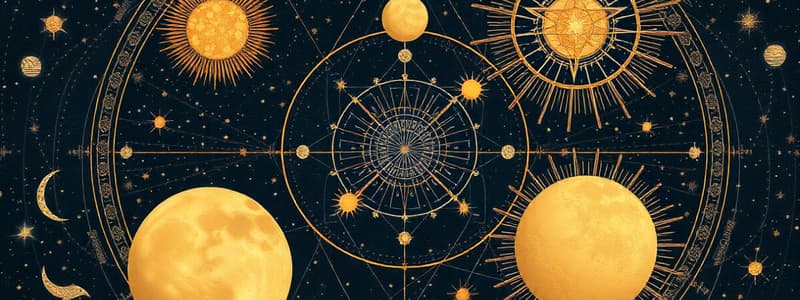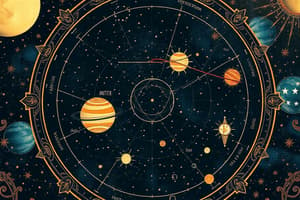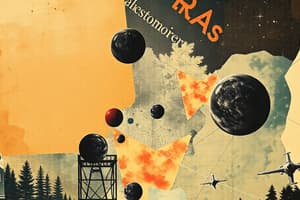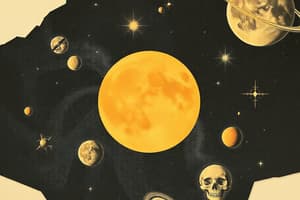Podcast
Questions and Answers
What are stars primarily composed of?
What are stars primarily composed of?
- Liquid water
- Solid ice
- Burning gases (correct)
- Molten rock
Why does the Sun appear larger and brighter than other stars?
Why does the Sun appear larger and brighter than other stars?
- It is much older
- It is made of different materials
- It is closer to Earth (correct)
- It is much further
What does the Earth move around?
What does the Earth move around?
- The Sun (correct)
- Other planets
- The Moon
- The stars
What is the Moon primarily made of?
What is the Moon primarily made of?
Which of these covers most of the Earth's surface?
Which of these covers most of the Earth's surface?
What is a large area of flat land called?
What is a large area of flat land called?
What is the layer of air surrounding the Earth called?
What is the layer of air surrounding the Earth called?
Which of the following do plants use to make food?
Which of the following do plants use to make food?
Why is the Sun crucial for life on Earth?
Why is the Sun crucial for life on Earth?
How do we see the moon at night?
How do we see the moon at night?
What distinguishes mountains from hills?
What distinguishes mountains from hills?
What role does the atmosphere play in sustaining life on Earth?
What role does the atmosphere play in sustaining life on Earth?
Why do stars seem small to us despite being very large?
Why do stars seem small to us despite being very large?
How do plains benefit human activities?
How do plains benefit human activities?
What distinguishes planets from stars?
What distinguishes planets from stars?
What would happen if the Sun suddenly stopped providing heat and light to Earth?
What would happen if the Sun suddenly stopped providing heat and light to Earth?
Stars are small pieces of rock that reflect light.
Stars are small pieces of rock that reflect light.
The sun appears bigger and brighter than other stars because it is the closest star to Earth.
The sun appears bigger and brighter than other stars because it is the closest star to Earth.
The moon produces its own light.
The moon produces its own light.
The Earth is mostly covered by land.
The Earth is mostly covered by land.
We do not need air to breathe.
We do not need air to breathe.
Plains are flat areas of land.
Plains are flat areas of land.
Mountains are smaller than hills.
Mountains are smaller than hills.
The atmosphere helps regulate the Earth's temperature.
The atmosphere helps regulate the Earth's temperature.
Stars generate heat and light through nuclear fusion processes.
Stars generate heat and light through nuclear fusion processes.
The Sun appears significantly brighter than other stars because it is larger in size.
The Sun appears significantly brighter than other stars because it is larger in size.
The Earth's atmosphere is primarily composed of helium and hydrogen, creating a breathable environment.
The Earth's atmosphere is primarily composed of helium and hydrogen, creating a breathable environment.
The Moon produces its own light through internal geological activity.
The Moon produces its own light through internal geological activity.
Oceans moderate Earth's temperature, due to water's high specific heat capacity.
Oceans moderate Earth's temperature, due to water's high specific heat capacity.
The Earth is the only celestial body within our solar system to possess an atmosphere and liquid water on its surface.
The Earth is the only celestial body within our solar system to possess an atmosphere and liquid water on its surface.
Mountains are formed solely through volcanic activity, resulting in their elevated height above the surrounding terrain.
Mountains are formed solely through volcanic activity, resulting in their elevated height above the surrounding terrain.
Plains regions are characterized by low levels of biodiversity compared to mountainous regions.
Plains regions are characterized by low levels of biodiversity compared to mountainous regions.
From Earth, when we look up, we see the ______.
From Earth, when we look up, we see the ______.
[Blank] are huge balls of hot, burning gases that give out heat and light.
[Blank] are huge balls of hot, burning gases that give out heat and light.
The Sun is a ______.
The Sun is a ______.
The Earth moves around the ______.
The Earth moves around the ______.
The ______ is a big ball of rock that moves around the Earth.
The ______ is a big ball of rock that moves around the Earth.
[Blank] are vast bodies of water that cover most of the Earth.
[Blank] are vast bodies of water that cover most of the Earth.
The Earth is surrounded by a layer of air called the ______.
The Earth is surrounded by a layer of air called the ______.
Stars are composed of hot, burning ______ and emit both heat and light.
Stars are composed of hot, burning ______ and emit both heat and light.
The Sun appears larger and brighter than other stars because it is the ______ star to Earth.
The Sun appears larger and brighter than other stars because it is the ______ star to Earth.
The reason we cannot see other stars during the day is due to the much brighter ______ from the Sun.
The reason we cannot see other stars during the day is due to the much brighter ______ from the Sun.
The Earth and Moon are similar in that they are both balls of ______.
The Earth and Moon are similar in that they are both balls of ______.
The Earth is unique in our solar system because it is surrounded by an ______ that provides breathable air and regulates temperature.
The Earth is unique in our solar system because it is surrounded by an ______ that provides breathable air and regulates temperature.
A ______ is defined as a large area of flat land, often used for agriculture and habitation.
A ______ is defined as a large area of flat land, often used for agriculture and habitation.
[Blank] are highlands, smaller than mountains.
[Blank] are highlands, smaller than mountains.
The Earth's atmosphere helps regulate the temperature, ensuring it is neither too hot nor too ______ for life.
The Earth's atmosphere helps regulate the temperature, ensuring it is neither too hot nor too ______ for life.
What does the Earth receive from the Sun?
What does the Earth receive from the Sun?
What type of body is the Moon?
What type of body is the Moon?
What is the Earth mostly covered by?
What is the Earth mostly covered by?
What do we call large areas of flat land?
What do we call large areas of flat land?
What is the name given to the lowland between two hills or mountains?
What is the name given to the lowland between two hills or mountains?
Why does the sun appear significantly larger and brighter compared to other stars observed from Earth?
Why does the sun appear significantly larger and brighter compared to other stars observed from Earth?
Explain why we cannot observe other stars during the daytime despite their constant presence in the sky.
Explain why we cannot observe other stars during the daytime despite their constant presence in the sky.
Describe the critical role of the Sun for life on Earth, going beyond just providing light.
Describe the critical role of the Sun for life on Earth, going beyond just providing light.
The moon does not emit its own light. Explain why we can see the moon from Earth.
The moon does not emit its own light. Explain why we can see the moon from Earth.
The Earth's surface is composed of both water and land. Why are oceans and seas important?
The Earth's surface is composed of both water and land. Why are oceans and seas important?
How do plains contribute to human activities and sustenance, asides from offering land to live on?
How do plains contribute to human activities and sustenance, asides from offering land to live on?
Distinguish between mountains and hills, and the landform found between them.
Distinguish between mountains and hills, and the landform found between them.
Explain the dual role of the atmosphere in supporting life on Earth (besides breathing).
Explain the dual role of the atmosphere in supporting life on Earth (besides breathing).
Explain why the Sun appears significantly larger and brighter than other stars when, in reality, stars are much larger?
Explain why the Sun appears significantly larger and brighter than other stars when, in reality, stars are much larger?
Describe the relationship between the Sun, the Earth, and the Moon, outlining their movements relative to each other.
Describe the relationship between the Sun, the Earth, and the Moon, outlining their movements relative to each other.
How does the Earth's atmosphere contribute to making the planet habitable for living organisms?
How does the Earth's atmosphere contribute to making the planet habitable for living organisms?
Explain why the land on Earth is important for human life, even though it covers a smaller portion of the Earth's surface than water.
Explain why the land on Earth is important for human life, even though it covers a smaller portion of the Earth's surface than water.
Describe the role of the Sun in sustaining life on Earth, and explain what would happen in the absence of the Sun's energy.
Describe the role of the Sun in sustaining life on Earth, and explain what would happen in the absence of the Sun's energy.
If the Moon does not produce its own light, explain why it is visible from Earth and describe the source of its illumination.
If the Moon does not produce its own light, explain why it is visible from Earth and describe the source of its illumination.
Explain the difference between mountains and hills.
Explain the difference between mountains and hills.
Compare and contrast planets and stars in terms of their composition and light emission.
Compare and contrast planets and stars in terms of their composition and light emission.
Flashcards
What are stars?
What are stars?
Huge balls of hot, burning gas that gives out heat and light.
What is the Sun?
What is the Sun?
The star closest to Earth.
What is the Moon?
What is the Moon?
A big ball of rock that moves around the Earth. It reflects light from the sun.
What is the Earth?
What is the Earth?
Signup and view all the flashcards
What are oceans?
What are oceans?
Signup and view all the flashcards
What are plains?
What are plains?
Signup and view all the flashcards
What are hills?
What are hills?
Signup and view all the flashcards
What is the atmosphere?
What is the atmosphere?
Signup and view all the flashcards
What are mountains?
What are mountains?
Signup and view all the flashcards
What is a valley?
What is a valley?
Signup and view all the flashcards
Why are stars invisible during daytime?
Why are stars invisible during daytime?
Signup and view all the flashcards
What is sunlight used for?
What is sunlight used for?
Signup and view all the flashcards
What are planets?
What are planets?
Signup and view all the flashcards
What is Earth's land?
What is Earth's land?
Signup and view all the flashcards
Why does the Moon shine?
Why does the Moon shine?
Signup and view all the flashcards
Why is the Sun important?
Why is the Sun important?
Signup and view all the flashcards
What are stars made of?
What are stars made of?
Signup and view all the flashcards
What do we see in the sky?
What do we see in the sky?
Signup and view all the flashcards
Where do we live?
Where do we live?
Signup and view all the flashcards
What is a landform?
What is a landform?
Signup and view all the flashcards
What can we see in the sky?
What can we see in the sky?
Signup and view all the flashcards
Why Sun is bigger and brighter?
Why Sun is bigger and brighter?
Signup and view all the flashcards
What surrounds the Earth?
What surrounds the Earth?
Signup and view all the flashcards
What are flatlands?
What are flatlands?
Signup and view all the flashcards
What do stars emit?
What do stars emit?
Signup and view all the flashcards
What moves around the sun?
What moves around the sun?
Signup and view all the flashcards
What are plains used for?
What are plains used for?
Signup and view all the flashcards
What is the Moon's location?
What is the Moon's location?
Signup and view all the flashcards
What is the Earth's atmosphere?
What is the Earth's atmosphere?
Signup and view all the flashcards
What are the highest lands called?
What are the highest lands called?
Signup and view all the flashcards
What are smaller highlands?
What are smaller highlands?
Signup and view all the flashcards
What is the atmosphere's role?
What is the atmosphere's role?
Signup and view all the flashcards
Why do stars appear tiny to us?
Why do stars appear tiny to us?
Signup and view all the flashcards
Why can't we see stars in daytime?
Why can't we see stars in daytime?
Signup and view all the flashcards
Why do stars appear very small?
Why do stars appear very small?
Signup and view all the flashcards
How do we use land?
How do we use land?
Signup and view all the flashcards
What does the Moon do?
What does the Moon do?
Signup and view all the flashcards
How dos the atmosphere help us?
How dos the atmosphere help us?
Signup and view all the flashcards
Study Notes
Stars and the Sun
- Stars give out heat and light.
- The Sun is a star.
- The Sun is a huge ball of burning gas.
- Without the Sun's heat and light, there would be no life on Earth.
- The Sun is important to us.
The Moon
- The Moon moves around the Earth.
- It is much closer to us than the Sun.
- It shines because the light from the Sun falls on it.
The Earth
- The Earth is our home.
- It is also home to many other living things, such as plants, animals, and insects.
- The Earth is a planet.
- Like the Moon, the Earth is a ball of rock.
Land
- Land covers only a small part of the Earth.
- We grow food and build houses, roads and railway tracks on land.
Atmosphere
- We need air to breathe.
- The atmosphere also makes sure that the Earth is neither too hot, nor too cold for us to live.
Studying That Suits You
Use AI to generate personalized quizzes and flashcards to suit your learning preferences.




